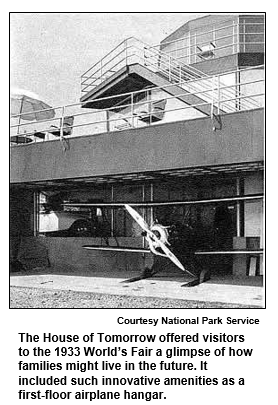Jan 1, 2021
On the shores of Lake Michigan at the Indiana Dunes, five distinctive houses - including the legendary House of Tomorrow - are the focus of nearly as much public interest as the famous sand dunes. They also are the focus of this encore show originally broadcast in 2018. Designed as showplace homes for the 1933 Chicago World's Fair, the houses were brought by barge to the resort town of Beverly Shores, Ind., after the fair closed.
During the 80-plus years since arriving at their permanent location, the former exhibit houses - which include residences known as the Florida House and the Cyprus House - have had their share of ups and downs.

"In the midst of the Great Depression, the House of Tomorrow ... offered millions a hopeful vision of a brighter, easier future," noted Indiana Preservation, a publication of Indiana Landmarks.
Perched on the Dunes, the five former exhibit houses are the only remaining structures from the 1933 Chicago World's Fair, which had a "Century of Progress" theme. Since the mid-1960s, the houses have been part of the Indiana Dunes National Lakeshore. Owned by the National Park Service, the houses are leased to Indiana Landmarks, the historic preservation organization. Landmarks, in turn, subleases them to tenants who agree to maintain them.

Todd Zeiger, director of Indiana Landmarks' northern regional office in South Bend, is Nelson's studio guest to describe the colorful saga of the five distinctive homes in Beverly Shores.
At the 1933 Chicago World's Fair, 1.2 million people paid 10 cents apiece to tour the House of Tomorrow.
In 2016, the National Trust for Historic Preservation designated the house a "National Treasure," a label reserved for "significant structures in dire straits," according to a story in the Indianapolis Star. Because of their location on the Dunes, the houses take a beating from Mother Nature; wind, sand and the harsh winters of far-northern Indiana conspire to make preservation an on-going challenge.

"The House of Tomorrow's nationwide publicity made it an extremely attractive promotional addition to Beverly Shores from Robert Bartlett's perspective," Morrow wrote. "Bartlett had the house sited high on a dune overlooking the lake to take advantage of its transparent walls."
Chicago architect George Fred Keck designed the House of Tomorrow, which the press in 1933 described as "America's First Glass House."
The Florida House was designed by a Miami-based architect. The pink, Modernist-style house at the Chicago World's Fair captivated visitors, many of whom were living in houses built in Tudor, Queen Anne, Italianate and other architectural styles prevalent during the Victorian and Edwardian eras.
For virtual tours of the "Century of Progress" houses from the 1933 World's Fair and their restorations, our guest Todd Zeiger of Indiana Landmarks recommends these online sources:
